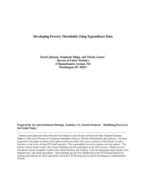
An official website of the United States government
Here’s how you know
Official websites use .gov
A .gov website belongs to an official government organization in the United States.
Secure .gov websites use HTTPS
A lock (
) or https:// means you’ve safely connected to the .gov website. Share sensitive information only on official, secure websites.
-
//
- Census.gov /
- Library /
- Census Working Papers /
- Developing Poverty Thresholds Using Expenditure Data
Developing Poverty Thresholds Using Expenditure Data
Developing Poverty Thresholds Using Expenditure Data
Abstract
In this paper, we examine each five issues, focusing on the data and methodological issues related to the estimation of thresholds using CE data. We find that alternative definitions of the reference threshold do not significantly change the thresholds, with the treatment of homeownership having the largest effect. Thresholds based on imputed rents for owners result in lower thresholds than when the thresholds are based on out-of-pocket shelter costs, while higher thresholds result when shelter costs for owners are defined as reported rental equivalence. We find that updating the threshold using the change in median expenditures (the Panel’s proposed method) rather than the change in the all-items Consumer Price Index (CPI-U) leads to a slightly larger increase in the thresholds between 1982 and 1995, but the change in median expenditures has a higher variance than the change in the CPI-U. We also find that the geographic adjustment recommended by the Panel (a cost-of-living housing index based on a Housing and Urban Development (HUD) approach) yields similar results to those using BLS inter-area price indexes for 11 major expenditure categories. In addition, we find that the equivalence scale recommended by the Panel yields similar thresholds (using a two-adult, two-child reference household) to those resulting if other household types are chosen as the reference unit.
To assist in examining the effects of these methodological issues, we use thresholds derived in this study along with cash incomes from the Current Population Survey (CPS) to produce poverty rates for selected population groups in the U.S. in 1995. Replacing the Panel’s cost-of-living housing index with one that accounts for more expenditure items has a minimal effect on the overall poverty rate, yet this replacement changes the poverty rates by region—rising in the Northeast and metropolitan areas and falling in the South and non-metropolitan areas. The percentage of poor children is not as sensitive to the equivalence scale used as are the percentage of elderly, married couples, and unrelated households.
In section I, we review the Panel’s proposed formula for computing the thresholds and defining the reference unit and examine alternative methods for computing the thresholds. Section II examines the treatment of shelter expenditures in the thresholds. Section III deals with the Panel’s recommendation to update the thresholds over time. Section IV compares the geographic adjustment made by the Panel to BLS experimental inter-area price indexes. Section V evaluates the adequacy of the proposed two-parameter equivalence scale used to produce the Panel’s thresholds. Section VI compares the thresholds to CPS income data to show the impact of changing the threshold definition on poverty rates and the distribution of the poverty population.
Others in Series
Working Paper
Working Paper
Working Paper
Share
Related Information
WORKING PAPER
Supplemental Poverty Measure Working PapersSome content on this site is available in several different electronic formats. Some of the files may require a plug-in or additional software to view.
 Yes
Yes
 No
NoComments or suggestions?


Top

